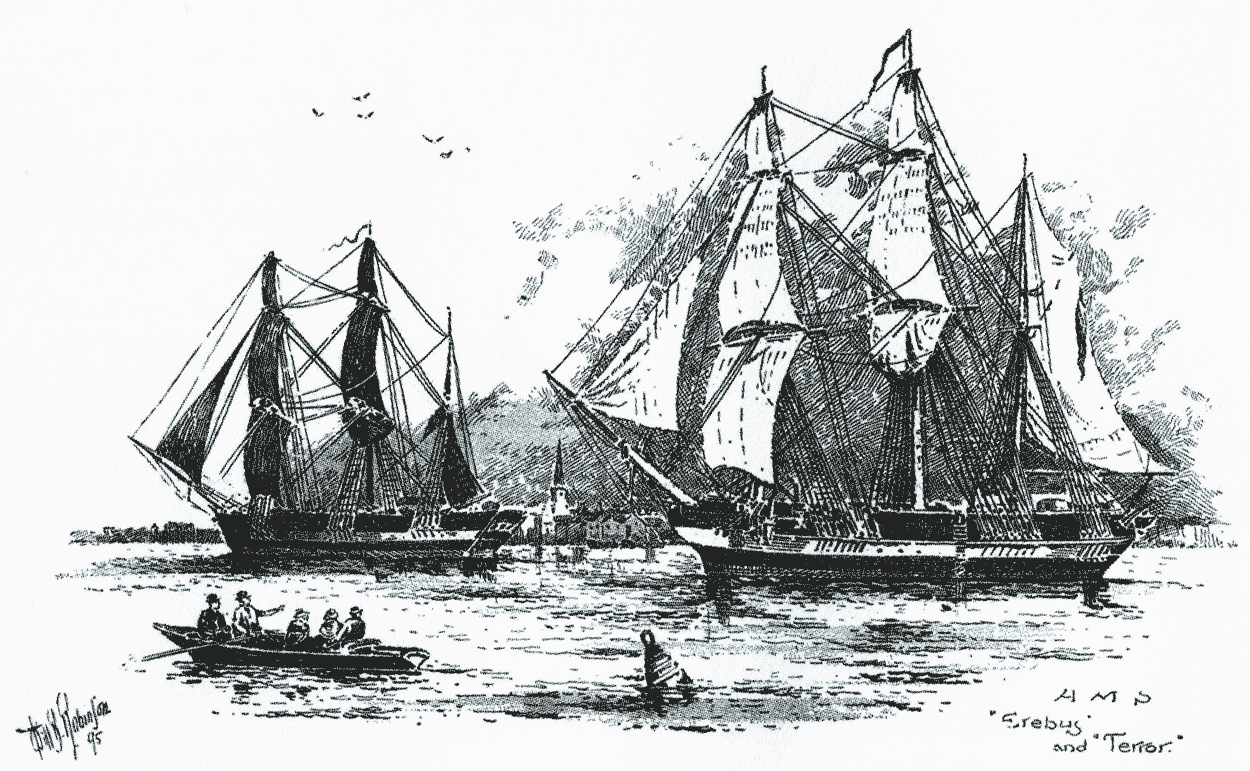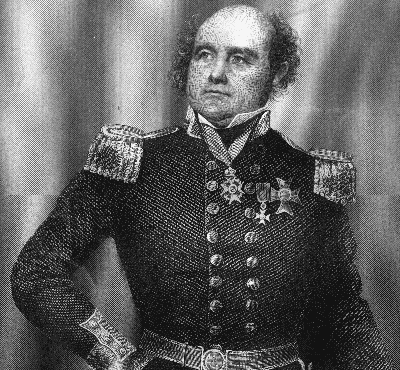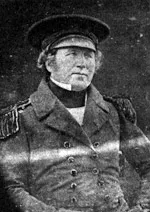Not here: The white north has thy bones; and thou, heroic sailor-soul, art passing on thine happier voyage now toward no earthly pole*.
Erebus and Terror - John Franklin
In Search of the North-West
Passage
A prestigious expedition to find the fabled northern route from Europe to South East Asia, "The Orient" to enable trade. Franklin died after 2 years and the ships were sunk after 3, all the crew were lost, but it would be 9 years before the story first came out and 33 years before rescue and recovery attempts ended.
*Alfred, Lord Tennyson, inscription on a memorial to Sir John Franklin in Westminster Abbey erected by his widow, Lady Jane Franklin. Painting by Francois Etienne Musin - HMS Erebus in the Ice , 1846
Franklin North West Passage Map | Franklin North West Passage Timeline | Erebus and Terror in Antarctica
1845 - The ships and the start of the journey
At the center of this story are two ships, HMS Erebus and HMS Terror. These were bomb ships designed to carry heavy mortar and cannon to bombard shore targets from the sea. They were reinforced to take the considerable weight and recoil of the guns and so were stronger than other similar sized ships, this strengthening meant they were selected for polar work where they might encounter ice, without the guns of course.They had already been on a four year voyage to the Antarctic from 1839-1843 led by James Clark Ross, a famous historic voyage of discovery. Mount Erebus, an active volcano in Antarctica and Mount Terror a nearby inactive volcano are named after the ships.
Erebus was 19 years old and Terror 32 years old by the start of the expedition already having had eventful lives. They were fitted with 20hp steam engines taken from the railways with screw propellers that allowed the ships to progress at 4 knots, the steam produced also provided heating and generated freshwater.
The Northwest Passage is a sea route from the Western
Atlantic to Eastern Pacific Ocean so allowing European
merchants quicker and easier access to the markets of the orient,
specifically China and Japan without having to sail around South
Africa or the Americas. It was initially imagined as something
that might be there, the search began in the late 1400's.
In 1745 the British Admiralty promised a £20,000 prize
for whoever discovered this passage. By the early 1800's
exploration became more scientific concerned with mapping the
arctic coastline rather than the former "lets go and have
a try" approaches.
John Barrow, Second Secretary
of the British Admiralty from 1804 to 1845 had coordinated and
initiated much of the scientific mapping operations. He organized
a major expedition that he thought would finally determine whether
or not a Northwest Passage existed at all. On the 19th of May
1845 the Erebus and Terror with a combined
crew of 133 set out from England under the command of Sir John
Franklin to find the enigmatic sea route, Franklin was an explorer
who had already led two overland expeditions. 129 of these men
were to enter the Arctic after their supply ship had left for
home. None would return.
At 59 Franklin was widely considered
too old and unfit for such an undertaking. The first choice,
James Ross couldn't be persuaded to take the position (at
44 he thought himself too old) and political rather than practical
reasons had a large part to play in Franklin's appointment.
There were many detractors, John Ross, the uncle of James offered
to lead a rescue expedition if nothing had been heard by February
1847, this even before Franklin set off.
1845 - Early days - no news is good news
Barrow thought the expedition might make
it through the northwest passage within a single season,
so avoiding overwintering, though this was
unlikely and there were provisions for three years along
with hunting equipment that could be used to supplement
preserved rations.
Erebus and Terror
were accompanied to Greenland by a supply ship which
returned to England bearing letters from the crews of
the two ships.
On the 26th of July 1845, two
whaling ships saw Franklin's expedition in northern
Baffin Bay which they reported on arrival back home
in England in August. It appeared that all was well
and on schedule. It was to be the last contact the expedition
had with the outside world.
The crew were inexperienced
in the polar regions with only very few having been
to the Arctic previously, though Franklin had and Crozier
the captain of the Terror had returned two years previously
from the Antarctic where he had also been captain of
the same ship in James Clark Ross's four year long
expedition.
The diaries from the Erebus (where
Franklin was stationed) that were eventually found report
that these early days had a positive, benign and
happy atmosphere where success was assured and failure
not contemplated.
Crozier was less convinced
however and presided over a ship less convivial. Both
captains had a feeling they would not return home alive,
shared only in their written thoughts.
In a time
before telecommunications and with the ships heading
to a region where they would likely be iced in for the
winter with plenty of provisions to get them through
and no likely contact for several months each year,
no-one worried about what might be happening, no news
was what was expected. However when no news arrived
during the whole of the next year 1846, concerns began
to form.
The expedition was expected to take
around three years.
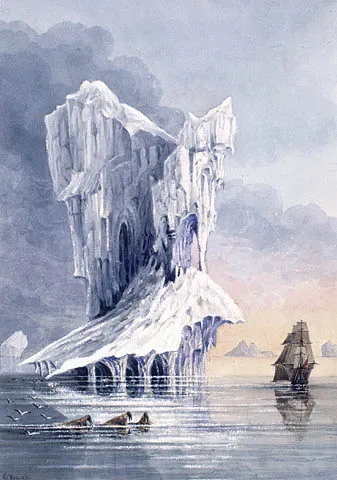
HMS Terror and walrus near the entrance of Hudson Strait. There are many paintings from the latter half of the 19th century of Erebus, Terror and scenes from the expedition, all of them were painted by artists who weren't there. In some cases the ships clearly don't look like the real ships, but some representative the artist imagined. In other cases such as this the artist seems to have never seen an actual iceberg or has decided to exaggerate the features to the fantastical.
1847 - Rescue offer rejected then accepted
On the 9th of February 1847 John Ross true to his word to Franklin before he set sail approached the Admiralty Board in London with a rescue plan. He was initially rejected, as he was again later with a more detailed plan and as was another plan from a Dr. King. The expedition had been away for two winters at this point, it was known that they had provisions for at least another one.Eventually by November 1847 in the continued absence of sightings or further news, a rescue mission was prepared by James Ross and accepted by the Admiralty Board. By the spring of the following year 1848, two sea-borne rescue missions set off along with a land attempt. Another (now the third) winter had passed since the expedition set off. None of these early missions found anything at all.
John Barrow died in November 1848 and with him any interest in the Franklin expedition from the Admiralty, or so they would have preferred. Franklin's disappearance was a major news story of the day, he was a hugely popular public figure and his disappearance only served to make him more so. Eventually the response of the Admiralty was to offer £20,000 for the rescue of Franklin, £10,000 for finding his ships and another £10,000 for finding the northwest passage. The issue was handed over to the Arctic Council.

The Arctic
Council planning a search for John Franklin
1850 - Rescue missions find something...... then the trail goes cold
Franklin's widow, Lady Jane Franklin became obsessed with finding her husband or at least his remains. She spent her time and money financing expeditions and when the money ran low, she lobbied others for funds. In 1850 fifteen ships entered the Arctic on search missions including two American, one expedition was financed directly by Lady Franklin and another small two-vessel expedition was financed and led by the now 73 year old John Ross. They had no real idea where to look. The main difficulty was an unawareness (despite much advice from people who were aware) of the capricious nature of ice in the search area, what can be clear one year can be blocked for the next several, such was the case with the Peel Channel, clear when encountered by Franklin in the summer of 1846, but blocked by ice during subsequent searches.
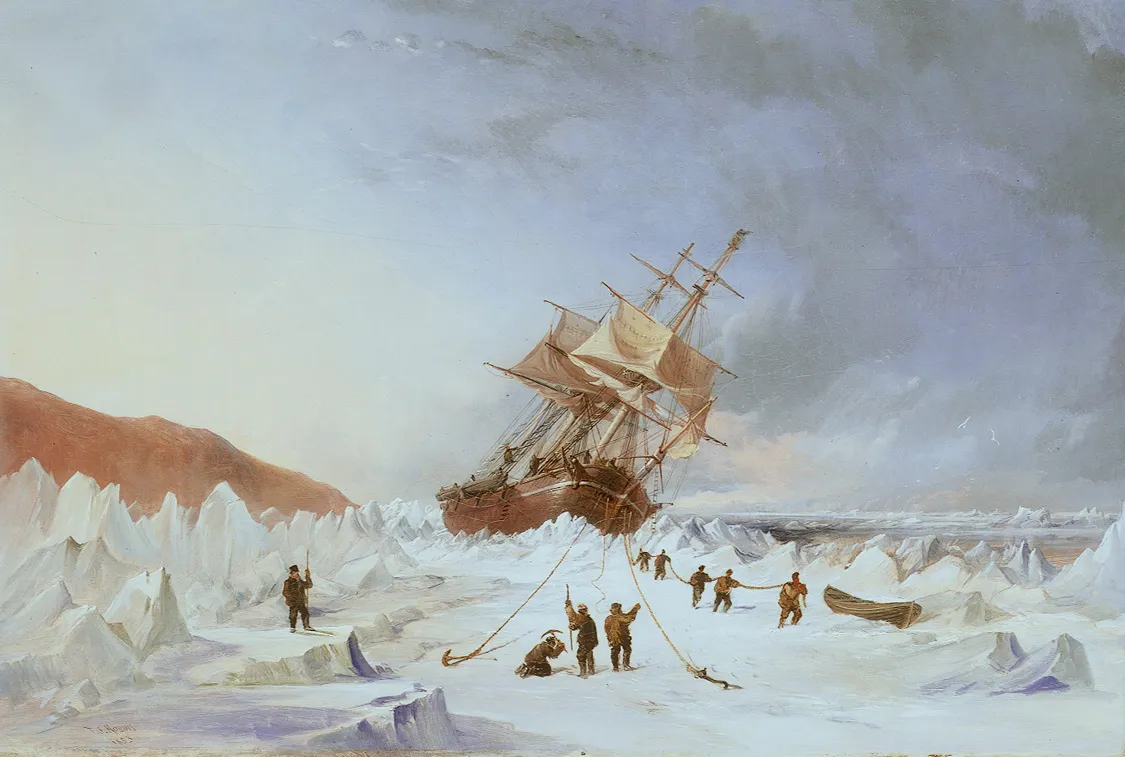 HMS Assistance,
one of four ships that winter in the ice near Beechey Island
in 1850, it returned to England in 1851 before the winter, having
found no trace of the lost expedition.
HMS Assistance,
one of four ships that winter in the ice near Beechey Island
in 1850, it returned to England in 1851 before the winter, having
found no trace of the lost expedition.
Sledge tracks were found extending at least forty miles up a nearby channel and it was assumed that these represented scouting parties Franklin sent out for the next summer (which would have been 1846 - 4 years previously by now). The search parties settled into a protected bay for the winter.
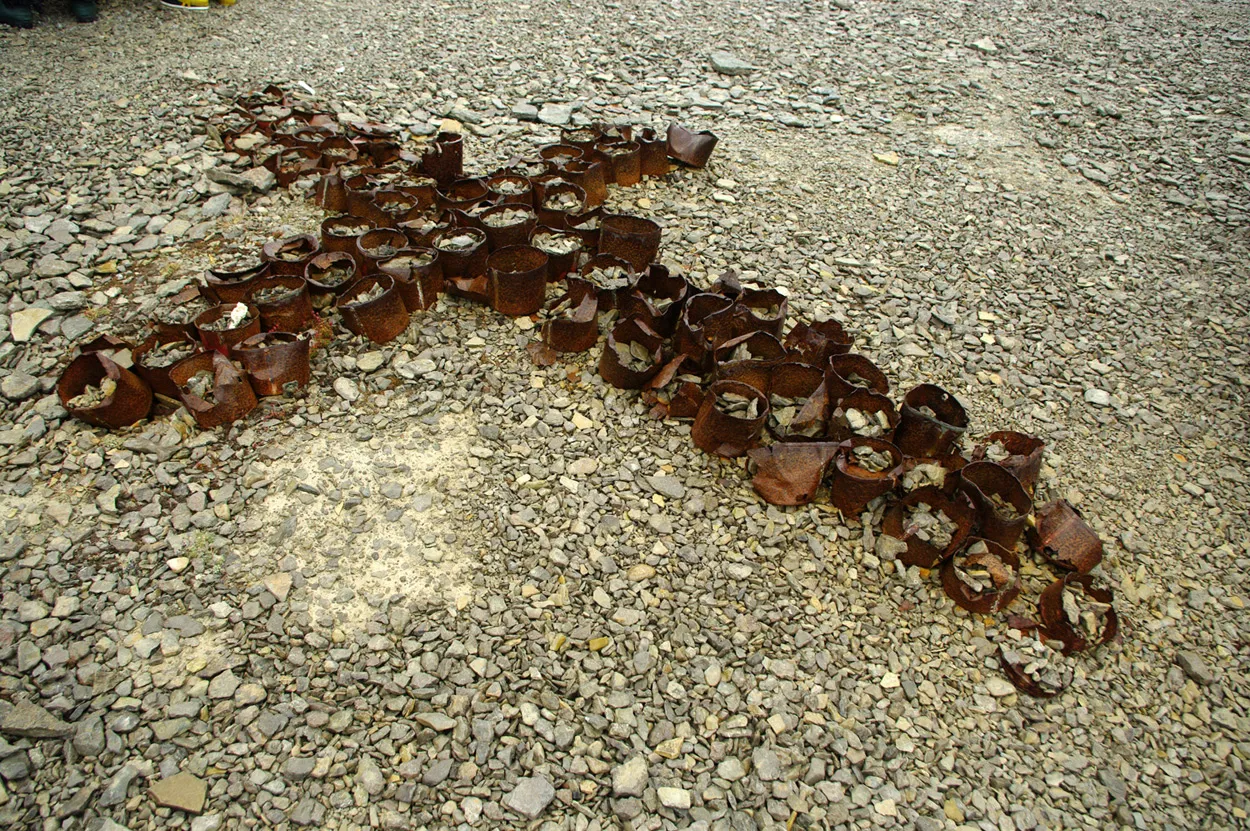
Beechey Island
2010, empty cans from the winter of 1845 still litter the ground,
these filled with
stones so as not to blow away and arranged into a cross.
The ships crews endured the endured the winter at a place they called Union Harbour more or less cheerfully. They also went out on numerous sledging expeditions, manhauling. No further signs were found of Franklin or the two ships or the 129 men that winter or by the ships that fanned out in the summer when the winter ice had cleared, and so they returned to England in 1851 carrying with them a rumour via some convoluted connected whispers that Franklin and his men had been killed by the Inuit.
After this enormous costly search that essentially found nothing, the Admiralty had even less desire to continue. Franklin by now had attained an almost legendary status and while the public had lost interest in the North West Passage, it was becoming a matter of national pride to find out what had happened to England's hero.
Every one had an opinion about what had happened, so it seemed of where Franklin had gone and what should be done to find him. Arctic foxes were captured and had notes attached around their neck with details of where to find food in the hope that the men of the expedition might capture them and read the notes, a similar idea was also tried with balloons. Medals were struck and handed out to the Inuit so if they found any trace of the expedition, they would know where to find the searchers and inform them.
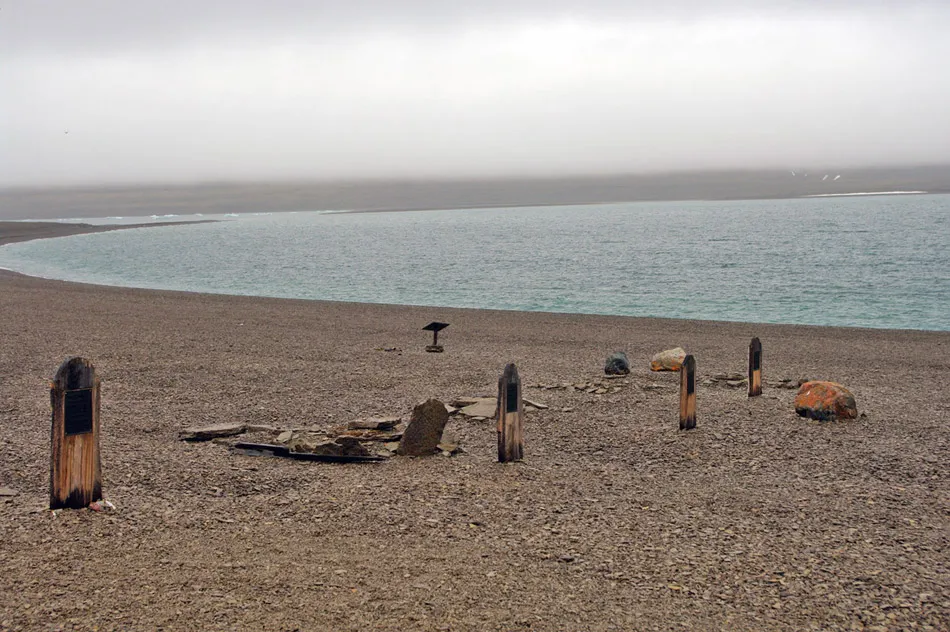
Four graves
on Beechey Island, three from the Erebus and Terror
in 1846 and one from the Investigator in 1854
1852 - 5 ships look in the wrong place, incidental rescue, 4 ships lost
The main problem was that the search efforts were being made in the wrong place. The Wellington Channel was considered to be the most likely place to look, it is 500 miles almost due north from where the wreck of one of Franklin's ships would eventually be found. This expedition led by the unsuitable Sir Edward Belcher consisted of the ships: Assistance, Resolute, Intrepid, Pioneer and a supply ship, the North Star.
The ships froze in for the winter and Belcher's pettiness and harsh application of the rules soon earned him many detractors and downright enemies, especially in the long, cold, dark winter night. Life on the frozen-in ships with Belcher was so unpleasant that almost all the men who could were volunteering for sledging expeditions, the level of discomfort of this being preferable to being on the ship. Belcher himself thought he was deliberately being told to look in the wrong place in order that he may be able to make an attempt on the North Pole if the opportunity presented itself, a situation that he resented and couldn't have helped his attitude to the men in his command. This is considered to be the first expedition that was ostensibly "Looking for Franklin" where in reality it was a euphemism for making a attempt on the north pole. In subsequent years many similar expeditions had the same public and hidden agendas.
Belcher was ready to abandon his quest and go home when he received new orders, to search for the ships Investigator and Enterprise which had gone to search for Franklin in 1850 and had become not quite lost as such, but their whereabouts were unknown. In April 1853 sledging parties left the Resolute for what was to become a 105 day 1,400 mile journey, though they made only geographical discoveries. Another party went west and found the Investigator frozen into the ice at Mercy Bay, the now near starved crew had entered the Arctic in the west by the Bering Strait, the captain McClure thought he would be able to reach the Atlantic and become the first to traverse the North West Passage, spurred on in no small part by the £10,000 prize.
 HMS Enterprise and
HMS Investigator searching for Franklin.
Investigator was to make
two journeys to the Arctic in search of the Franklin expedition,
in the second, leaving in 1850 it became trapped in the ice
and was abandoned three years later (the crew was rescued by
the Resolute after a long overland walk). The wreck
of the Investigator was discovered in 11m of water
by marine archeologists in 2010.
HMS Enterprise and
HMS Investigator searching for Franklin.
Investigator was to make
two journeys to the Arctic in search of the Franklin expedition,
in the second, leaving in 1850 it became trapped in the ice
and was abandoned three years later (the crew was rescued by
the Resolute after a long overland walk). The wreck
of the Investigator was discovered in 11m of water
by marine archeologists in 2010.
More sledging trips were made along the routes that Franklin might have taken, still to no avail. By February 1854 Belcher had become sufficiently worried about the safety of his frozen in ships and men that he ordered them to be abandoned and all crews to board the North Star and return to England, fortunately the crews were able to be divided amongst a further two other supply ships that arrived.
Belcher was subject to the automatic court martial for any captain who lost a ship, he had lost for out of five. While he was exonerated, the verdict was interpreted more as "not proven" than of actual innocence. He was never again given an active command. Later on, the abandoned Resolute broke out of the ice and drifted to Davis Strait where it was salvaged by an American whaler 19 months later who couldn't believe his luck.
1853 - Franklin's fate revealed
It was a man called John Rae a doctor and an overland man for the Hudson Bay Company who found what had happened to Franklin. While exploring the one empty space left by previous expeditions in 1853 he encountered a group of Inuit who told him of an encounter they had four years previously in 1849-50.
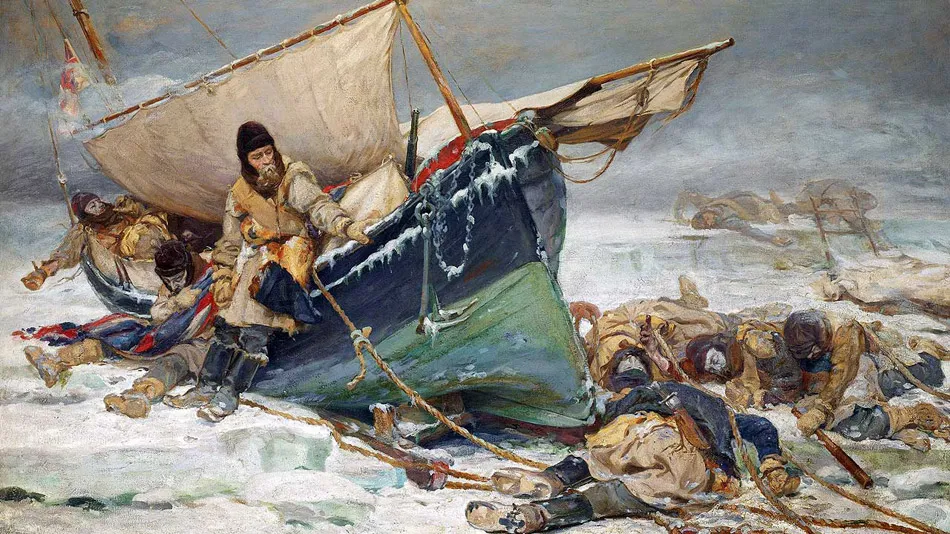
Sir John Franklin's
Men Dying by Their Boat During the North-West Passage Expedition
by W. Thomas Smith
National Maritime Museum - object
BHC1273
The Inuit told of a group of forty men dragging a boat south, they were all very thin and using sign language made it known that their ship had been crushed in the ice, they purchased a seal from the Inuit. Later the same season, the the same party were encountered, or at least what remained of them about a days walk from the Great Fish River. The men Rae spoke to had not seen the group first hand but were recounting a story told to them by others.
The scene described was apocalyptic, there were scattered dead bodies, in tents, under the upturned boat or out in the open. Many of the bodies has been hacked with knives and human remains were reported in cooking pots, they said there were thirty dead in that place, another five dead were found on a nearby island. The Inuit also reported hearing gunshots later in the year after the game had returned (so probably after May) indicating that not all of the men had died by that time. To confirm the story they told Rae, they sold him a number of artifacts, a silver spoon, silver forks and similar with initials and names that confirmed their provenance as belonging to the officers of the Erebus and Terror.
Rae stated "From the mutilated state of many of the corpses, and the contents of the kettles, it is evident that our wretched countrymen had been driven to the last resource - cannibalism - as a means of prolonging existence".
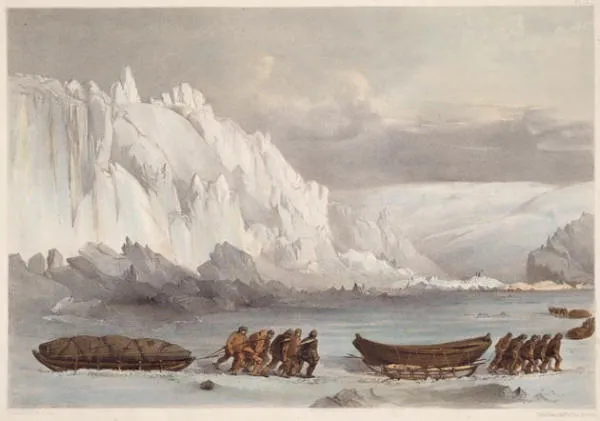
Picture courtesy - Library and Archives
Canada, Peter Winkworth Collection of Canadiana
Rae's report caused great consternation when it reached England. The Admiralty were relieved as they could now stop searching. Lady Franklin and the Arctic Council were shocked, not only was the news of death but death by starvation and with cannibalism thrown in to boot. They did the only reasonable thing they felt they could, they doubted the story and shunned Rae.
Rae had not seen the scenes described or even the region and why were the men in such an unlikely place? The Hudson's Bay Company sent out a team to where they thought the Inuit had seen the scenes they described. Wood and some relics were found connected to the Erebus, but no signs of dead bodies.
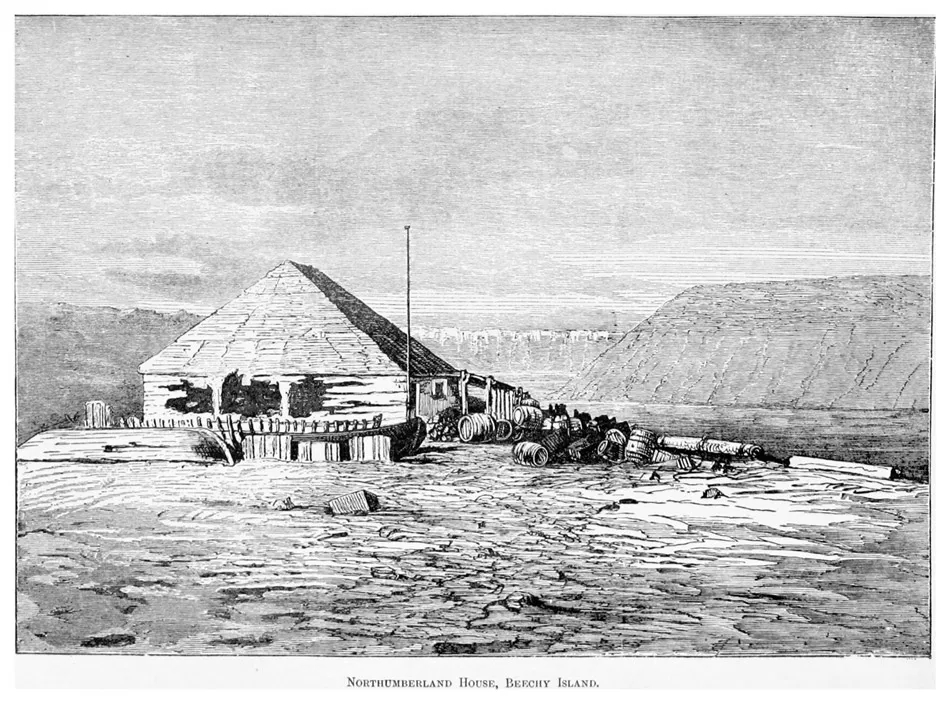
Northumberland house
on Beechey Island built in 1854 and filled with supplies for
Franklin or any of his crews who might find it, pictured here
in 1859
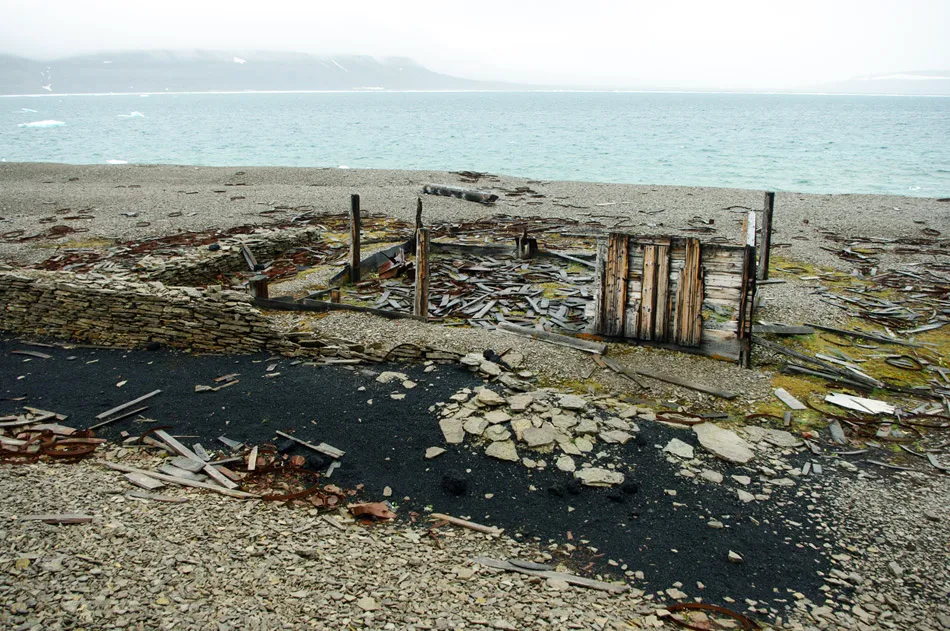
The remains of Northumberland
house in 2010, a small dry-stone wall can be seen to the left
and the remains of a coal stack in the fore-ground. The space
inside the building is filled with barrel hoops and staves.
1857 - Lady Franklin raises funds for yet another rescue mission
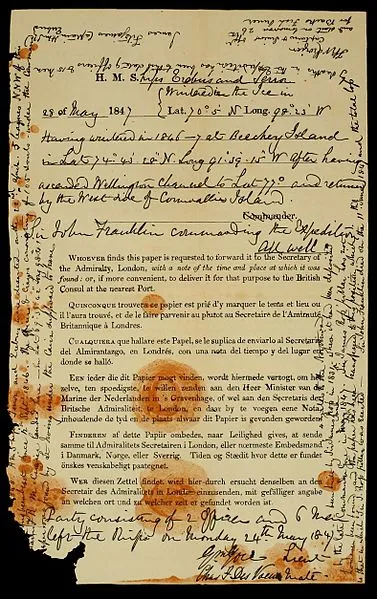 Another ship, the Fox
in the command of Leopold McClintock was dispatched to the Arctic
to search for what it could. Even Lady Franklin accepted
that her husband was almost certainly dead now, 12 years after
departure, he would have been 72 years old. It was hoped that
some of the younger, fitter members of the crew would have survived
or that at least journals and diaries might be discovered to
cast a light on what had happened.
Another ship, the Fox
in the command of Leopold McClintock was dispatched to the Arctic
to search for what it could. Even Lady Franklin accepted
that her husband was almost certainly dead now, 12 years after
departure, he would have been 72 years old. It was hoped that
some of the younger, fitter members of the crew would have survived
or that at least journals and diaries might be discovered to
cast a light on what had happened.After two years, in 1859 following a difficult and at times harrowing journey, the Fox was able to start investigating the lost expedition of Franklin. Inuit told of seeing men travelling to the south some dropping dead as they walked, a ship that had many books that became wrecked and the body of a big man with long teeth.
Eventually the first body was found, apparently having fallen down as the man walked, then the remains of a cairn though without a message and then finally a cairn with a message still intact written in the spaces around a page from a book.
28 of May, 1847 lat. 70° 05' N. long. 98° 23' W.
Having wintered in 1846 at Beechey Island in lat. 74° 43' 28" N.; long. 91° 39' 15" W., after having ascended Wellington Channel to lat. 77° and returned by the west side of Cornwallis Island.
Sir John Franklin commanding the expedition.
All well.
Party consisting of 2 officers and 6 men left the ships on Monday, 24 May 1847.
The date of wintering 1846-7 at Beechey Island is a mistake, the Beechey Island winter was the previous one in 1845-6, with 1846-7 having been spent in the James Ross Strait to the north of King William Island.
Handwritten around the margin of this was the following:
April 25, 1848 H. M. ships 'Terror' and 'Erebus' were deserted on the 22d April, 5 leagues N. N. W. of this, having been beset since 12th September 1846. The officers and crews, consisting of 105 souls, under the command of Captain F. R. M. Crozier, landed here in lat. 69° 37' 42" N., long 98° 41' W. Sir John Franklin died on the 11th June, 1847; and the total loss by deaths in the expedition has been to this date 9 officers and 15 men.
Signed by Captains Crozier and Fitzjames of the Erebus, it also states "and start (on) to-morrow, 26th, for Back's Fish River,".
This is the only written record of the expedition.
On the 28th of May 1847, all was as expected. Two weeks later Franklin was dead and soon another twenty four men had also died an unprecedented rate of casualties, some illness or disease seemed to have affected the crews.
1859 - The fate of the Franklin crews is revealed... partially
There were clues found by McClintock that hinted at a harrowing ordeal. After sledging seventy miles down the coast of King William Island an abandoned boat was found attached to a large cumbersome makeshift sledge. In the boat were two human skeletons, one much ravaged by wild animals, the other less so, next to which were watches and two guns loaded and propped upright. Also in the boat were large amounts of equipment including surprising items such as silk handkerchiefs, towels and sponges, hardly important things to take. There was some food, including an empty tin that had held twenty two pounds of meat. Books in the vicinity were marked "G.G" or "Graham Gore". The boat was not pointing south as might be expected if the men dragging it were trying to escape, but instead it pointed north back to where the Erebus and Terror had spent the second winter and where they had been abandoned.
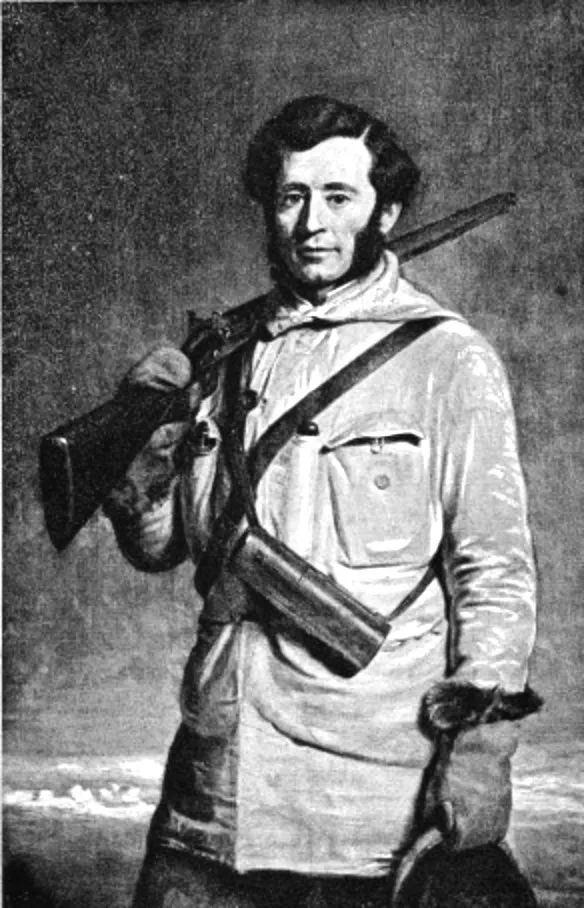 Leopold McClintock in 1859
Leopold McClintock in 1859
At another place, Victory Point a huge amount of discarded equipment was found, winter clothing, four heavy stoves with other metal items such as barrel hoops, a wooden block from the ships rigging, navigational gear, a medicine cabinet, and an enormous amount of winter clothing, though the notable absence of any food or even empty food tins.
There were more questions than answers, why had the sledge contained so many frivolous items while the equipment at Victory Point was far more useful but left behind? Why was there so little food, the expedition had been equipped with easily enough tinned food to last to 1848 and beyond even if it hadn't been eked out with game caught during the summer months. The fact that so much useful equipment had been left undisturbed implied that any food had not been taken Inuit.
North of Victory Point three cairns were found, the first, after three miles had an empty canister, the second had nothing at all, the next one was surrounded by the remnants of three small tents and some other scraps. A piece of folded paper was found tucked into the rocks of the cairn but was blank, two broken corked bottles were found, if they had contained messages they had long since blown away.
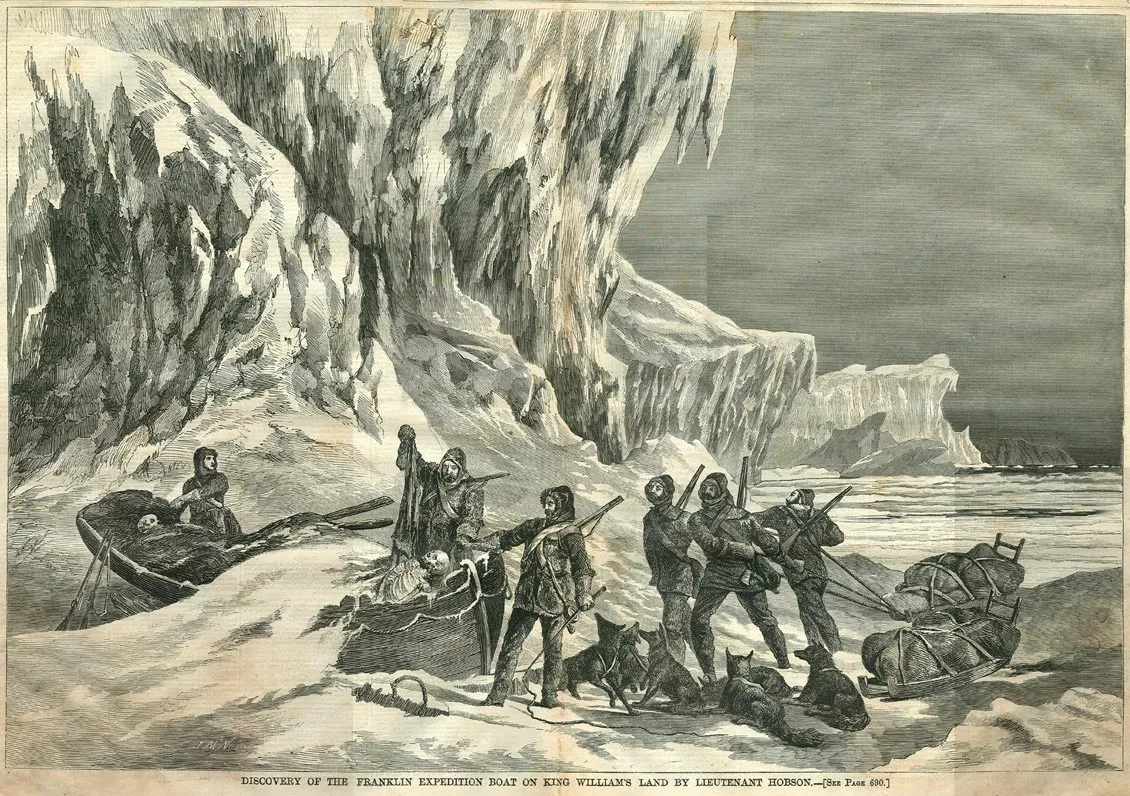 Discovery
of the Franklin's Expedition Boat on King William's
Land by Lieutenant Hobson
Discovery
of the Franklin's Expedition Boat on King William's
Land by Lieutenant Hobson
An illustration in the magazine Harper's
Bazaar
The monetary cost of the search expeditions had been enormous:
British Admiralty - £675,000 (£90M
- 2020 equivalent)
Lady Jane Franklin and subscriptions
- £35,000 (4.8M - 2020 equivalent )
US
government - $150,000 (just over $5M - 2020 equivalent
)
American Henry Grinnell - $100,000
($3.3M - 2020 equivalent )
Still, the mystery was unsolved, no survivors had been found, much of the evidence was contradictory or just unfathomable. The north west passage had still not been discovered or even fully proven to exist, Franklin and the rescue missions found where the passage wasn't. Expeditions continued sporadically for 19 more years including another one part funded by Lady Franklin in 1874. The last expedition took place in 1878, it found many relics, several graves were identified along with exposed corpses that were given proper burial. The main conclusion was that no further records from Franklin's Expedition had survived. This signaled the end of Franklin related search or rescue missions, 31 years after the first and 33 years since the expedition left England.
It would be another nearly fifty years before Roald Amundsen made the passage with a small crew in a small boat with a very shallow draught. The journey took them five years as they were frozen in each winter and even then they only just scraped through. Had Franklin's expedition found the route, the Erebus and Terror would probably not have been able to sail through. The perils of unpredictable sea-ice, the difficulty and treachery of shallow channels and shoals meant that it was useless for the hoped for purpose of a quicker sea-route from Europe to the Far East.
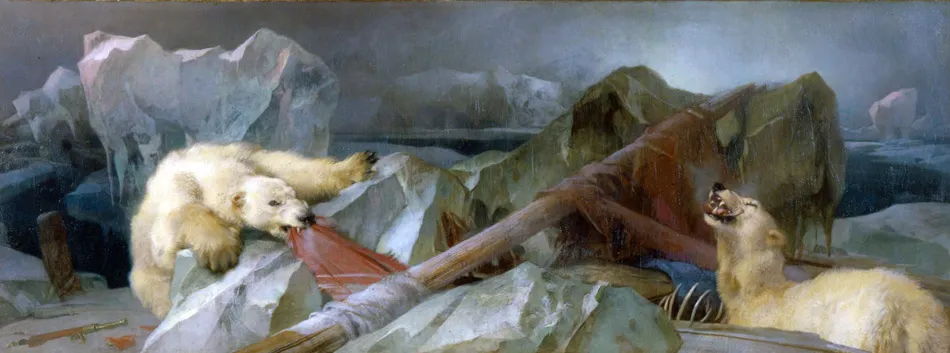
Edward Landseer
- Man Proposes, God Disposes 1864 - inspired by the
Franklin expedition
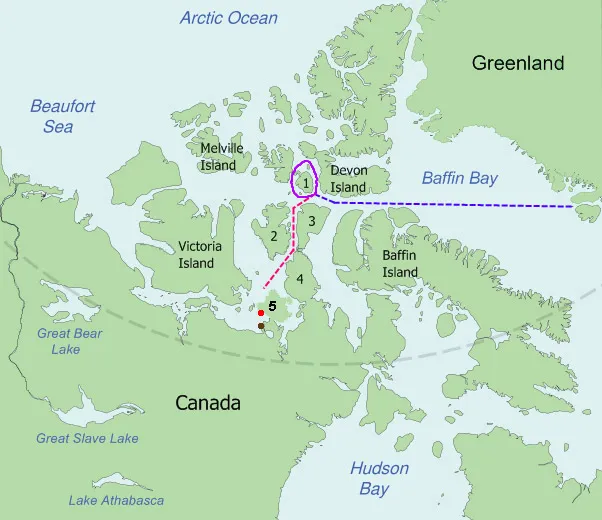
The path of the Franklin
Expedition.
Blue
- summer 1845, Disco Bay, Greenland to Baffin
Island, Canada.
Purple
- summer 1845, around Cornwallis Island (1).
Pink - summer 1846,
south down Peel Sound between Prince of Wales Island (2) and
Somerset Island (3). Boothia Peninsula (4) and King William
Island (5) where the bodies and relics were found.
Erebus found September 2014
- brown dot.
Terror
found September 2016 - red dot.
Modern investigations after 1980
 The corpse of John Torrington exhumed on Beechey Island in 1981, after 135 years in the permafrost it was remarkably well preserved |
The findings were inconclusive however as the lead levels could have accumulated over many years, the only way to find out was to compare to soft tissue lead levels. It was decided to exhume the bodies on Beechey Island and perform autopsies. Two of the (remarkably well preserved) bodies were raised in August 1984 and bone and tissue samples taken before they were reinterred. Pneumonia was found to be the ultimate cause of death, though there were soft tissue lead levels that indicated the men "would have suffered severe mental and physical problems caused by lead poisoning".
Initially the lead solder in the food tins were blamed for the lead poisoning, it is now thought that while this may have been contributory, the most likely explanation is that the lead came from a new system used for the first time on this expedition where fresh water from the steam engines was collected in tanks using lead pipes and lead soldered joints.
Another forensic expedition in 1992 identified high lead levels in bones and marks consistent with de-fleshing on nearly 400 bones and fragments from another site on King William Island.
The view today is that a number of factors were to blame for the loss of the crews of the Erebus and Terror. Lead poisoning would have had a significant effect with disease such as scurvy, pneumonia and tuberculosis affecting the weakened men, added to this are the effects of bitter cold and starvation.
With a lack of any real kind of written record and the fact that the artifacts are wide-spread and have been disturbed and/or lost before proper forensic archeological studies can be carried out, it is unlikely that the full story that slowly unfolded over four or five years will ever be properly known.
A number of searches for the wrecks of the Erebus and Terror found nothing for a long time. In 2010 however, the remains of H.M.S. Investigator, one of the would be rescue ships that became icebound before being abandoned and subsequently sinking were found upright and reasonably intact in 11m of water at Mercy Bay, Banks Island.
2014 - Erebus found, 2016 - Terror found
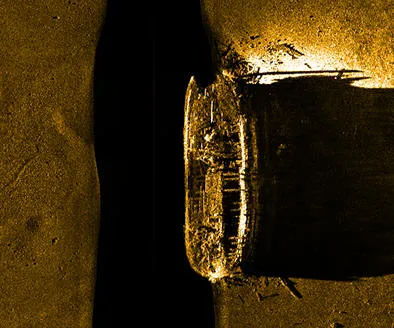 On
the 9th of September 2014 a search called the "Victoria
Strait Expedition" found one of Franklin's ships in
east Queen Maud Gulf to the west of O'Reilly Island. Initially
it was not clear which ship had been found, later being identified
as the Erebus, it is well preserved
and largely intact.
More here from Parks Canada.
On
the 9th of September 2014 a search called the "Victoria
Strait Expedition" found one of Franklin's ships in
east Queen Maud Gulf to the west of O'Reilly Island. Initially
it was not clear which ship had been found, later being identified
as the Erebus, it is well preserved
and largely intact.
More here from Parks Canada.Almost exactly two years later on the 11th of September 2016 a ship wreck found about 24m (80ft) down in a bay to the south of King William Island was surveyed by a small remotely operated submersible vehicle. It was found to be the Terror in a remarkably intact state of preservation. There are plates and a can on a shelf and glass panes still intact in 3 of the 4 tall windows in the stern cabin. The findings imply that the ship sank slowly after being shut up and prepared for the winter. More information here.
The Terror was found about 60 miles (96 km) further south of where it was thought to have been crushed by the sea ice. Its location and very well preserved state indicate that some of the crew may have closed the ship down and then attempted to sail south on the Erebus to escape their predicament rather than attempting to walk out of the Arctic as has been the accepted view so far.
Finding HMS Erebus, video 5 mins 48 secs - Parks Canada
Franklin North West Passage Map | Franklin North West Passage Timeline
Edward Landseer - Man Proposes, God Disposes - The Urban Myth
This picture (above) is on display at Royal Holloway College, London in a room that is used for examinations periodically through the year. A legend has built up amongst generations of students going back to the 1920's or 30's that the paining is cursed or haunted and anyone sitting in front of it during an examination would fail. On one occasion in the 1970's a student refused to sit their exam in front of the painting so the invigilator covered it with the first thing they found that was large enough which happened to be a Union Jack. This has developed into a tradition and now the painting is always temporarily covered with a Union Jack at exam times.
There later arose an urban myth that a student killed themselves after looking at the painting writing "The polar bears made me do it" on their exam paper. There is no record of such a death however, the student in question is sometimes described as a girl, sometimes a boy and there are three different supposed ways in which they killed themselves.

